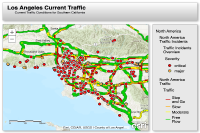 Hide Table of Contents
Hide Table of Contents
 Analysis
Analysis
 Dynamic Layers
Dynamic Layers
 Editing
Editing
 Feature Layers
Feature Layers
 Feature Table
Feature Table
 Graphics
Graphics
 Map
Map
 Mobile
Mobile
 Online and Portal
Online and Portal
 Popups and Info Windows
Popups and Info Windows
 Query and Select
Query and Select
 Renderers, Symbols, Visualization
Renderers, Symbols, Visualization
 Search
Search

Explore in the sandbox
View live sample
Description
This sample demonstrates how to display near real-time traffic information for different regions in the world on a map. The data is updated every 5 minutes. This map service requires an ArcGIS Online organizational subscription.
The color coded traffic map layer can be used to represent relative traffic speeds; this is a common type of a map for online services and is used to provide context for routing, navigation and field operations. The color coded map leverages historic, real time and predictive traffic data. A color coded traffic map can be requested for the current time and any time in the future. A map for a future request might be used for planning purposes.
The map also includes dynamic traffic incidents showing the location of accidents, construction, closures and other issues that could potentially impact the flow of traffic. Traffic incidents are commonly used to provide context for routing, navigation and field operations. Incidents are not features; they cannot be exported and stored for later use or additional analysis.
The service works globally and can be used to visualize traffic speeds and incidents in many countries. Check theservice coverage web mapto determine availability in your area of interest. In the coverage map, the countries color coded in green support visualizing live traffic. The support for traffic incidents can be determined by identifying a country. For detailed information on this service, including a data coverage map, visit theNetwork Analysis Services documentation.
Important Note: The World Traffic map service is available for users with an ArcGIS Online organizational subscription. To access this map service, you'll need to sign in with an account that is a member of an organizational subscription. If you don't have an organizational subscription, you can create a new account and then sign up for afree trial of ArcGIS Online.
For demonstration purposes this sample uses a webmap that has been setup to use aservice proxyso you aren't required to log-in with an ArcGIS Online organizational subscription to run the sample.
Code
<!DOCTYPE html>
<html>
<head>
<meta http-equiv="Content-Type" content="text/html; charset=utf-8">
<meta name="viewport" content="initial-scale=1, maximum-scale=1,user-scalable=no">
<title>World Traffic</title>
<link rel="stylesheet" href="https://js.arcgis.com/3.46/dijit/themes/claro/claro.css">
<link rel="stylesheet" href="https://js.arcgis.com/3.46/esri/css/esri.css">
<link rel="stylesheet" href="css/layout.css">
<script src="https://js.arcgis.com/3.46/"></script>
<script>
require([
"dojo/parser",
"dojo/ready",
"dijit/layout/BorderContainer",
"dijit/layout/ContentPane",
"dojo/dom",
"esri/map",
"esri/arcgis/utils",
"esri/dijit/Legend",
"esri/dijit/Scalebar",
"dojo/domReady!"
], function(
parser,
ready,
BorderContainer,
ContentPane,
dom,
Map,
arcgisUtils,
Legend,
Scalebar
) {
ready(function(){
parser.parse();
arcgisUtils.createMap("7bd3337fd9c14068bfb4a8e8071a9afa","map").then(function(response){
//update the app
dom.byId("title").innerHTML = response.itemInfo.item.title;
dom.byId("subtitle").innerHTML = response.itemInfo.item.snippet;
var map = response.map;
//add the scalebar
var scalebar = new Scalebar({
map: map,
scalebarUnit: "english"
});
//add the legend. Note that we use the utility method getLegendLayers to get
//the layers to display in the legend from the createMap response.
var legendLayers = arcgisUtils.getLegendLayers(response);
var legendDijit = new Legend({
map: map,
layerInfos: legendLayers
},"legend");
legendDijit.startup();
});
});
});
</script>
</head>
<body class="claro">
<div id="mainWindow" data-dojo-type="dijit/layout/BorderContainer" data-dojo-props="design:'headline'" style="width:100%; height:100%;">
<div id="header" class="shadow roundedCorners" data-dojo-type="dijit/layout/ContentPane" data-dojo-props="region:'top'">
<div id="title"></div>
<div id="subtitle"></div>
</div>
<div id="map" class="roundedCorners shadow" data-dojo-type="dijit/layout/ContentPane" data-dojo-props="region:'center'"></div>
<div id="rightPane" class="roundedCorners shadow" data-dojo-type="dijit/layout/ContentPane" data-dojo-props="region:'right'" >
<div id="legend"></div>
</div>
</div>
</body>
</html>